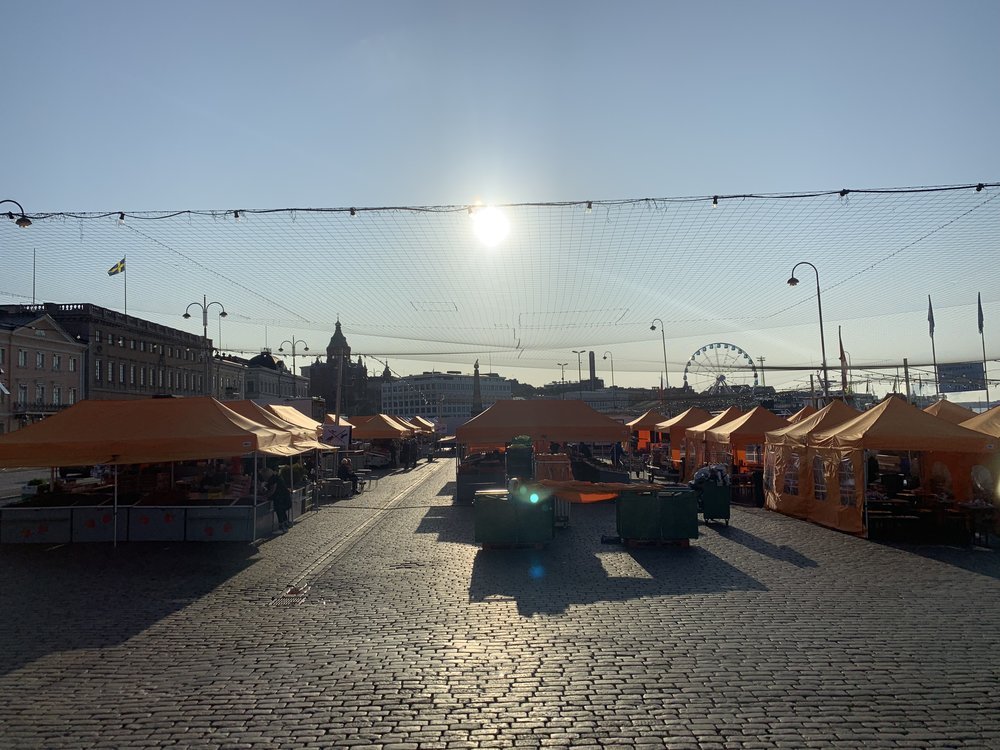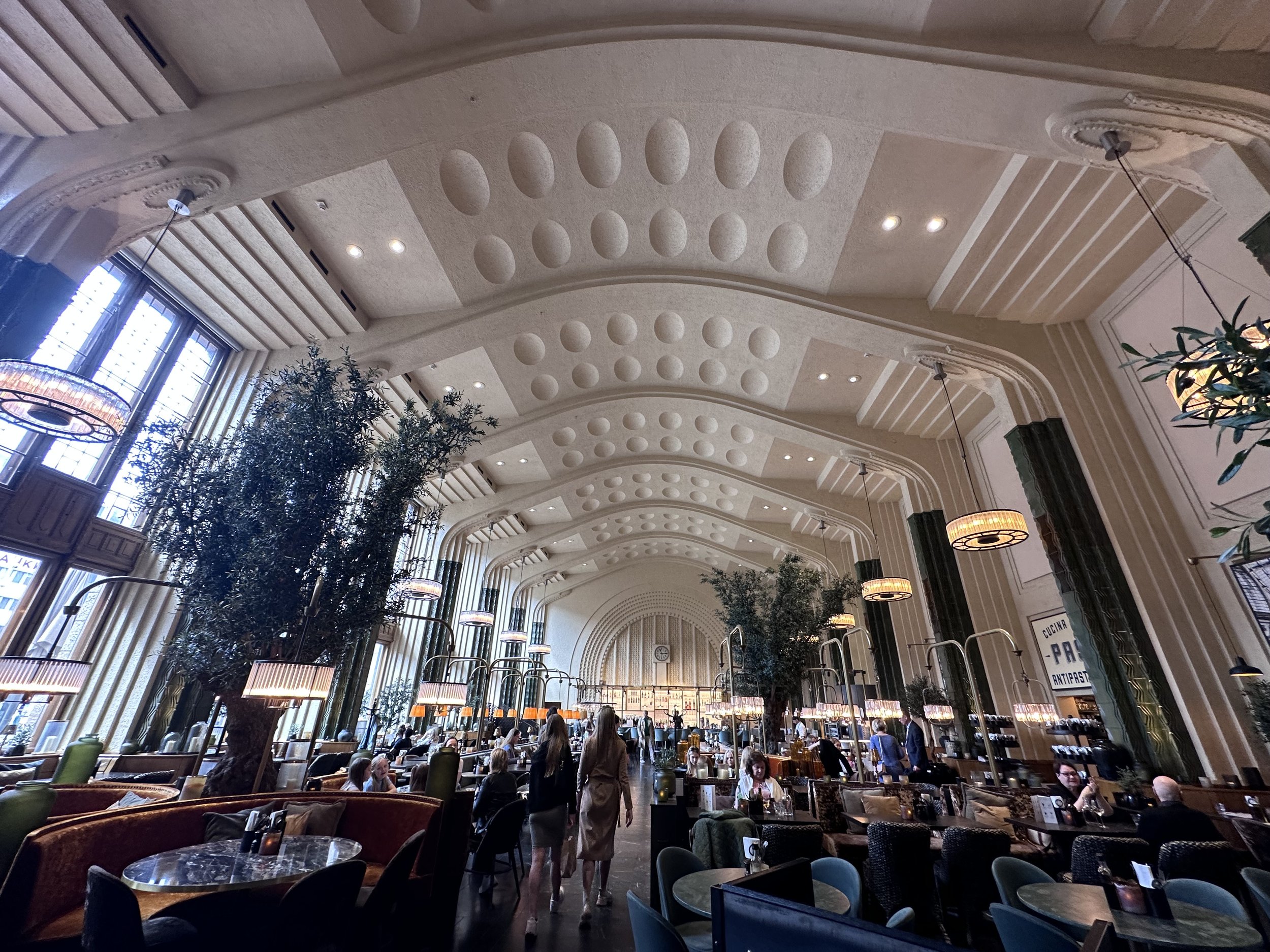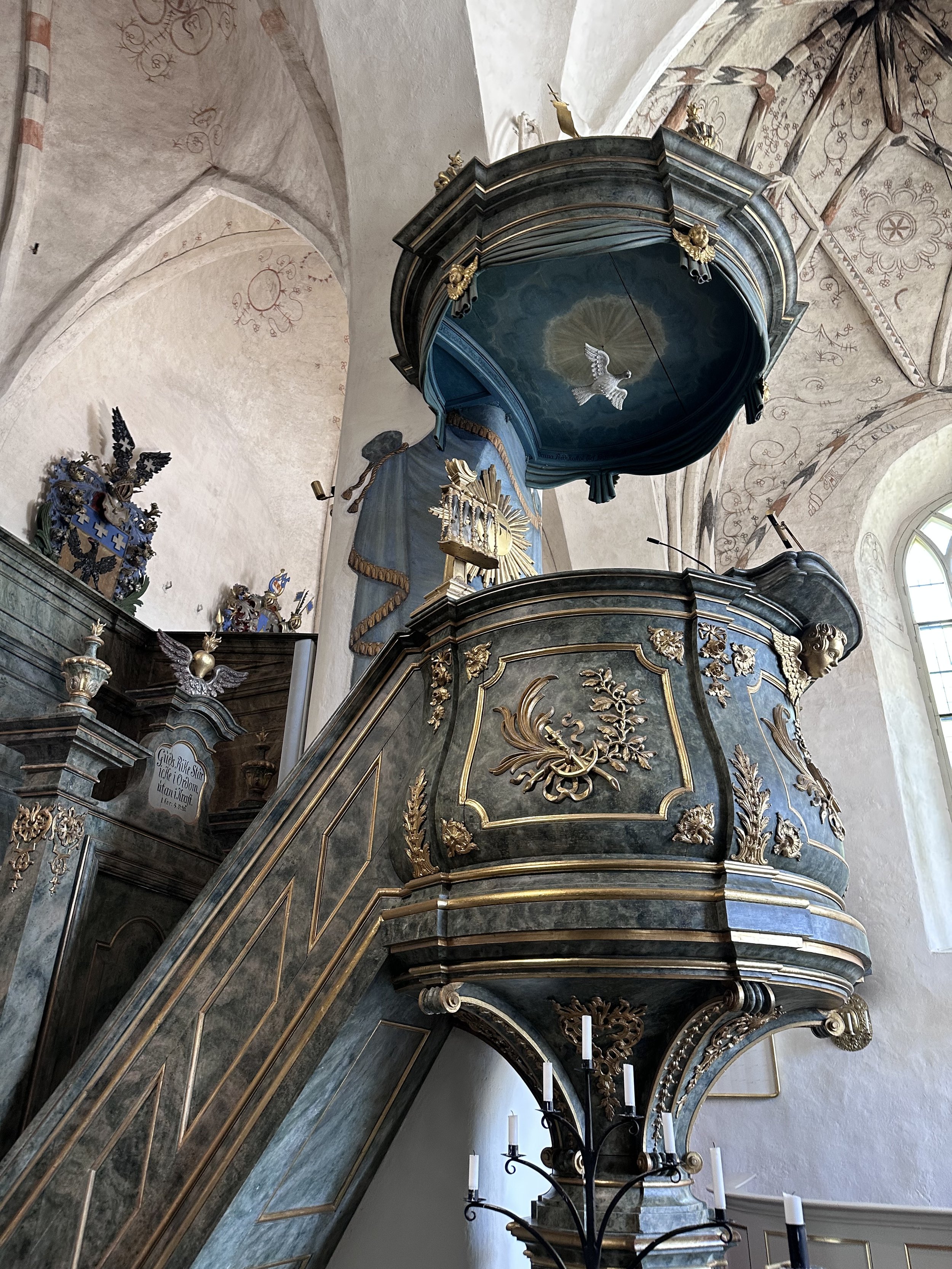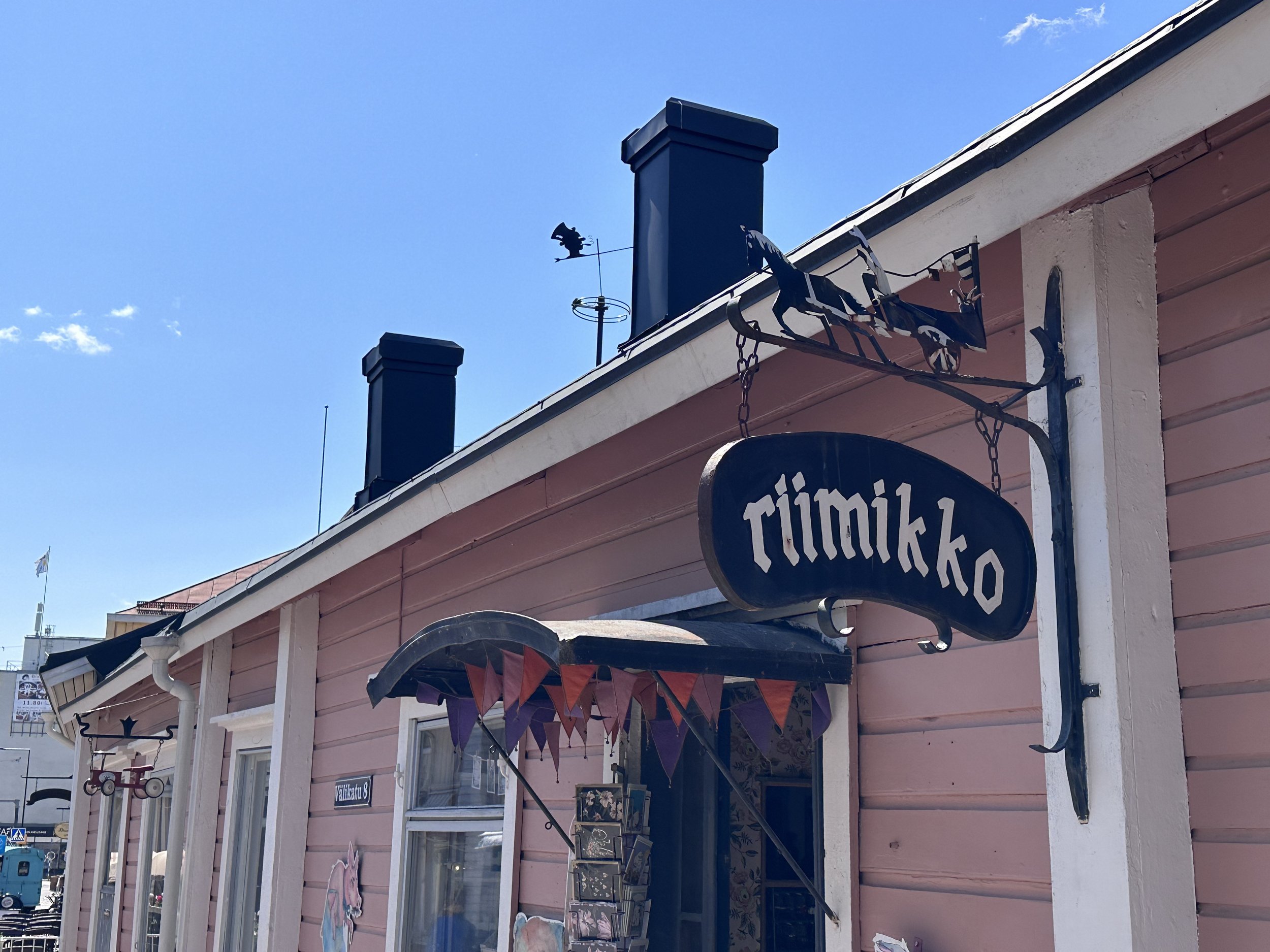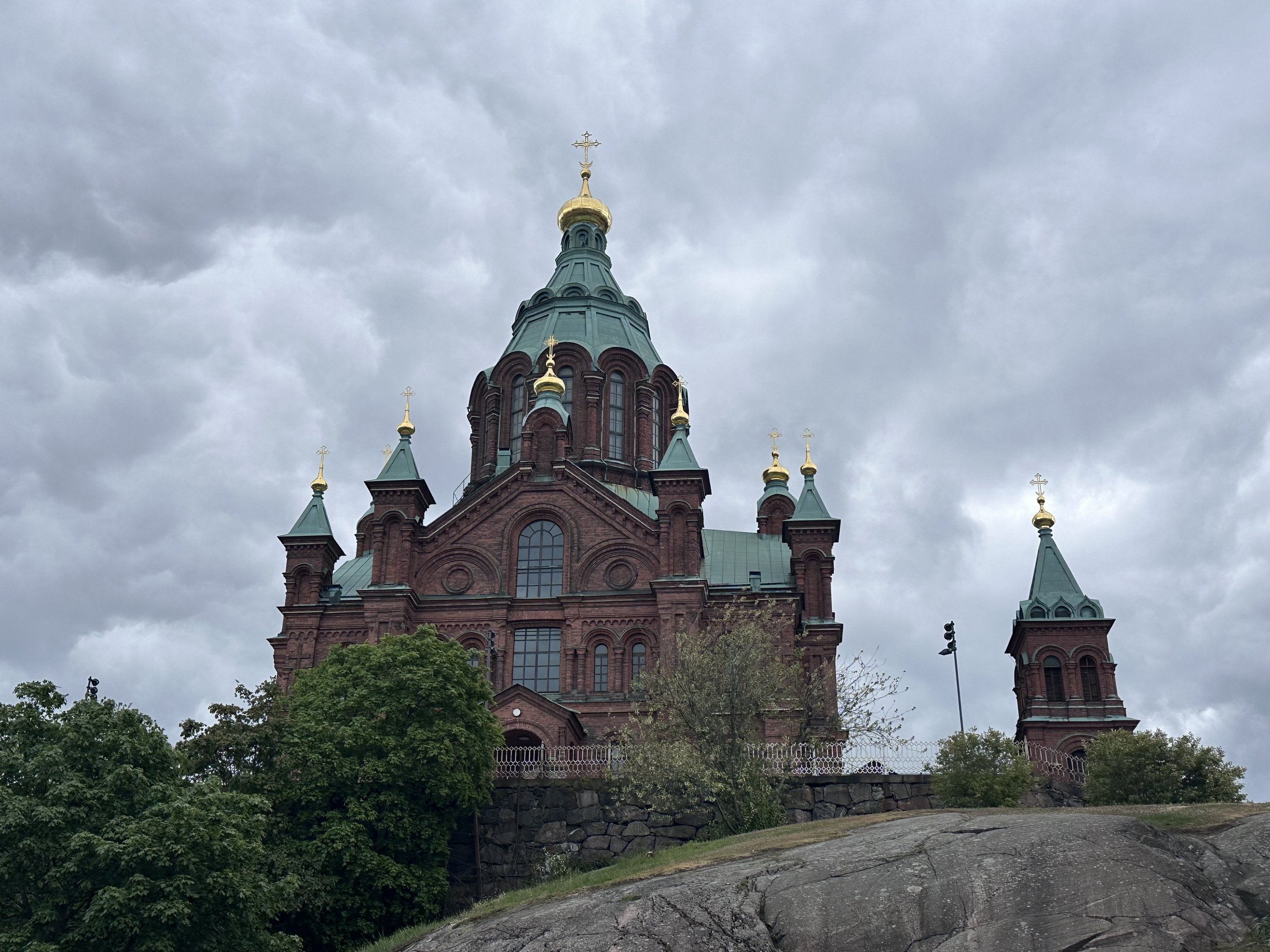Helsinki + Day Trips in Finland
Updated June 5, 2023
Time needed in Helsikni - 2-3 nights to take a couple of day trips
There are two things I love when I travel: Exploring lesser-known areas and charming little towns, of which Finland provides both. It’s a country that has so much natural beauty, fresh air, and history that it begs to be explored, which is why I’ve now been back to both Helsinki and Porvoo twice.
The below information is a complete guide of the best places to stay, the top rated places to dine and drink, and all there is to see and do. We’ve also included transportation tips, as well as a summary of the history of this wonderful country!
Jump To:
Where to Stay
Where to Dine & Drink
This is the only place we dined at and we absolutely LOVED that they catered so well to gluten-free! By far, it’s one of the best smash burgers we’ve had in the world.
Kaffa Roastery
Serving sustainably grown and roasted coffee.
Ravintola Noka
Serves Balkan cuisine.
Ravintola Nolla
Zero-waste restaurant offering seasonal flavours using local & organic products.
Ravintola Palace
Per their website, “Established in 1952, Palace has always been a pioneer of Finnish gastronomy. It was the first Finnish restaurant to receive a Michelin star in 1987. With views over the city and its seascape, the restaurant is located on the 10th floor of a historically significant building that was originally constructed to mark the 1952 Olympic Games in Helsinki. Today, the Palace kitchen is headed by Chef Eero Vottonen who, together with his team, aims to create an innovative yet sophisticated Nordic dining experience.”
Ravintola Ragu
Sophisticated restaurant serving creative, seasonal menus & wine pairings in a light-filled space.
Ravintola Spis
Informal, brick-lined eatery with a set menu featuring creative local dishes & desserts, plus wine.
Restaurant Demo
A Michelin-starred restaurant offering memorable experiences and delicious food in a relaxed environment.
Restaurant Grön
Cozy restaurant offering a menu of creative & seasonal contemporary Scandinavian cuisine.
Restaurant Kuu
French-influenced fine dining & wine in an old-timey setting with a covered terrace.
Restaurant Kuurna
Intimate eatery offering refined European fare, set-course menus & daily specials.
Restaurant Olivia Central Station
In updating this blog, I saw that this place has a lot of bad reviews (everyone expects the authentic italian experience but it’s a train station, which means efficiency is key) , which makes absolutely no sense. The decor, service, abundance of delicious gluten-free options, and overall experience were phenomenal!
Restaurant Olo
Fine dining venue presenting innovative tasting menus & wine pairings amid understated decor.
Restaurant Passio
Innovative restaurant serving tasting menus & wine pairings amid retro-chic surroundings.
Restaurant Pompier
Stylish French restaurant offering weekday lunch buffets & a la carte dinner options, plus wine.
Restaurant Rioni
Per their website, “Our Georgian restaurant Rioni offers a taste jump to the dishes of the traditional Georgian Dining Table. We serve hearty meals to both lovers of succulent meat stews and conquerors of vegetable plates. You can also get vegan food from us. “
Restaurant Savoy
Sophisticated choice executing French & Finnish cuisine in an iconic locale featuring city views.
Restaurant Vinkkeli
Per their site, “Vinkkeli can be described as a food and wine restaurant, presenting a friendly, honest, and uncomplicated take on classic cuisine, where the wine and drink selection is given the same devotion as the selection of ingredients in the kitchen.”
Things to See & Do
Day Trips
Just a couple of miles from Old Town Porvoo is a 15th century farm called Kiala Manor. Having been owned by many families throughout the centuries, it’s one of the most well-known and biggest farms in the town, and we were lucky to have lunch there.
Our group was treated to a multi-course meal including fresh salad, tender beef in a lingenberry reduction sauce, steamed vegetables, potato cakes, and for dessert, mini berry tarts (which I had to skip out on). And while the food was great, the atmosphere was even better, as we dined in the oldest part of the manor.
After lunch, we had time to walk around the grounds and also visit the gift shop (which I’d recommend). Truly, it’s one of the most “instagrammable” locations I saw on my trip.
Porvoo
This is one of my and Blackbeard’s favorite little towns, mainly for their chocolate, which is nearly the best in the world. Certainly, you can rent a car and drive to the town or you can take this tour to learn more about how this town started and evolved. We’ve included some of the must-sees below.
History Summary
The area of Porvoo has been inhabited since the Stone Age. In prehistoric times, the river Porvoonjoki was a route of commerce for Finnish tribal Tavastians who primarily inhabited the inland regions.
Porvoo was colonized by Swedes in the 13th and 14th centuries after the so-called Second Crusade against Tavastians in 1249–1250. The colonization was led by the Catholic Church and the kingdom of Sweden. The colonists originated from Svealand, and were provided with seeds, cattle and, tax exemption for four years.
The oldest known written mentions of Porvoo are from the early 14th century. Around 1380, Porvoo became the third town in Finland to be granted official town rights, after Turku in 1229 and Ulvila in 1365.
In 1721 Sweden lost the city of Vyborg to Russia, which prompted the move of the episcopal see to Porvoo in 1723, making it the second largest city in Finland.
In 1760, roughly two-thirds of all buildings in Porvoo burned to the ground in a conflagration. During rebuilding, the city planning wasn't altered, instead new buildings were built upon the existing medieval foundations.
After the conquest of Finland by Russian armies in 1808, Sweden had to cede Finland to Russia in 1809 (the Treaty of Fredrikshamn). The Diet of Porvoo in 1809 was a landmark in the History of Finland, as Tsar Alexander I confirmed the new Finnish constitution (which was essentially the Swedish constitution from 1772), making Finland an autonomous Grand Duchy.
In 1923, six years after Finland's independence, the former Diocese of Vyborg, which operated in Porvoo, was replaced by a current Swedish-speaking diocese of the Evangelical Lutheran Church of Finland, the Diocese of Porvoo
Brunberg is the most famous (and oldest) chocolate shop in Porvoo, well known for making high-quality chocolate and other sweets, for over 150 years. It’s the only chocolate shop I’ve seen that uses no gluten, soy, or dairy in many of their products, as well as naturally sweetening some purely with coconut. We thought we bought out the store, but the chocolate didn’t make it past a few days!
The first stone walls of the Porvoo Cathedral were built between 1410 and 1420, and in about 1450, the church was expanded 13 ft. towards the east and 20 ft. towards the south. Like many buildings during this time, the church was destroyed by numerous fires - once in 1508 by Danish forces, then in 1571, 1590, and in 1708 by Russian forces. It received cathedral status in 1723.
Things to note about the cathedral:
The ship model suspended from the ceiling belong to the King of Sweden in the 1700s, which he gifted to the cathedral before going back to his home country.
This was initially built as a Catholic church with the mass spoken in Latin. With the rule of the Swedes in the 1600s came the conversion to Lutheranism, with mass spoken in Swedish.
Our first stop on our Porvoo tour brought us to Porvoon Paahtimo Bar & Cafe to sample the local coffee. We learned that the Finnish drink up to FIVE cups a day, though now we understand why. The beans are lightly roasted, which gives it a weaker taste than most are used to. However, the beans this cafe uses are from the roastery next door, which is only sold in small amounts and distributed to few cafes across Finland.
Picture an attic full of old childhood treasures that you dust off and play with for an afternoon. Or, think of any childhood memory in which make-believe was part of daily life. This is where Riimiko comes in. Known for custom dollhouses and antique toys, Riimiko was a wonder for both children and adults alike (my new niece scored big time).
savonlinna
Embark on a special tour from Helsinki to Savonlinna that offers something truly unique. Experience the beauty of the Finnish countryside as you travel by car and enjoy a captivating daytime photography adventure on Lake Saimaa.
During this tour, you'll have the chance to visit Olavinlinna Castle, a fascinating medieval landmark filled with history and charm. But what makes this tour truly special is the opportunity to explore Lake Saimaa, which is home to endangered Saimaa ringed seals and other captivating wildlife.
Joined by a local photographer guide, you'll venture into the lake's archipelago to capture amazing moments with your camera. Watch as the seals relax on rocks, interact with each other, or peacefully enjoy their meals. Your guide will provide helpful tips to ensure you capture the best wildlife photos, and if you're into landscapes, the Saimaa archipelago offers plenty of picturesque scenes for you to capture.
sipoo
On our way to Porvoo, we stopped at Sipoo to visit the Old Church, otherwise known as St. Sigfrid’s Church, which was built in the mid-15th century.
While we had been in many medieval churches throughout the duration of our travels, we had never been in one that had no electricity and only a stone floor. Given its simplicity, it was one of the most impressive.
There is no history documented for this church, including who the architect was for it, but it’s still in use today for summer services and weddings. It’s also of note that the graves in the images below are for those local vets that died during WWII.
Taiga Forest Hike
Nature lovers will cherish this opportunity to experience the beauty and tranquility of Finland’s Taiga forest. The full-day excursion includes a guided hike through Liesjärvi National Park along with a traditional Finnish lunch cooked and eaten beside a lake. Hassle-free roundtrip transfer from central Helsinki makes it easy to get out of the city to experience this stunning natural habitat.
tallin, estonia
Most people take a simple ferry ride between Helsinki and Tallinn, but this tour takes it to the next level. After pickup from your hotel, head to the cruise ship and be escorted to a VIP cabin that features a buffet breakfast. Once you arrive in Tallinn, enjoy a guided tour of its highlights and learn about its rich history. Ride back to Helsinki in a private cabin while enjoying a lavish buffet dinner.
NOTE: We have been to Tallin and it’s a fantastic city to see! Click here for our experience.
Turku
6-hour tour of sightseeing and storytelling in Finland's pearl, Turku. Become familiar with Turku's intriguing landscapes, monuments and stories as you start the journey from one of the most inspiring cathedrals in Finland. Stroll the centuries-old Great Old Square and discover local landmarks and an authentic atmosphere. Admire the architectural and historical significance of Turku City Library and visit the centuries-old Market Square where unique ambiance unfolds. Gaze upon Turku's fascinating Market Hall and explore the city's oldest wooden house dating back several centuries in the past. End the peaceful walking tour at the picturesque landscapes of Riverboats As Finland’s oldest city and the former capital, Turku is a great spot for exploring Finland. Beautiful River Aura runs through the historic area of Turku, all the way from the medieval Turku Castle to the main cathedral surrounded by cobblestone streets and yellow brick buildings.
Historical Exploration
Fortress of Suomenlinna
Suomenlinna (Sveaborg) is a sea fortress that was gradually built from 1748, onwards, on a group of islands belonging to the district of Helsinki. The work was supervised by the Swedish Admiral Augustin Eherensvärd (1710-1772), who adapted Vauban’s theories to the very special geographical features of the region. The landscape and the architecture of the fortress have been shaped by several historic events. It has served to defend three different sovereign states over the years: the Kingdom of Sweden, the Russian Empire and most recently the Republic of Finland.
Consisting of 200 buildings and 6 km of defensive walls, the fortress stretches over six separate islands. The original fortress was built using local rock and fortified with a system of bastions over varied terrain. The purpose of the fortress was originally to defend the Kingdom of Sweden against the Russian Empire and to serve as a fortified army base, complete with a dry dock. Sandbanks, barracks and various other buildings were added during the 19th-century Russian period. The defensive system was adapted to match the requirements of a modern fortress and developed in the 19th century using contemporary fortification equipment.
After Finland gained independence in 1917, the fortress was renamed Suomenlinna (or Fortress of Finland) and served as a garrison and a harbour. The military role of the fortress declined after World War II, and in 1973 the area was converted for civilian purposes. Since then, buildings have been renovated to serve as apartments as well as workspaces, to house private and public services, and for cultural purposes.
You can take a day trip to this island, which many people do as it’s a nice respite from Helsinki for a few hours.
National Museum of Finland
The National Museum of Finland was built from 1905 to 1910 and opened to the public in 1916. It presents history from the Stone Age to the present day, through objects and cultural history. The Finnish National Romantic style building is located in central Helsinki and is a part of the Finnish Heritage Agency, under the Ministry of Culture and Education.
Religious History
Kamppi Chapel
The Kamppi Chapel is a chapel in the neighbourhood of Kamppi in Helsinki, located on the Narinkka Square. It is also known as the "Chapel of Silence" since it is intended to be a place to calm down and have a moment of silence in one of the busiest areas of the city. What’s amazing about it is its rounded wooden design as though you’re inside a bathtub. It’s worth a few moments there.
TEMPPELIAUKIO CHURCH (THE ROCK CHURCH)
Temppeliaukio Church, otherwise known as “The Rock Church”, was quarried out of solid granite in 1969. This church was one of the first modern churches built in Helsinki and the only of its kind to have a copper wire dome at the top (aside from the fact that its walls are of solid rock).
Uspenski Cathedral
After Helsinki was made into the capital of Finland in 1812, in 1814, Alexander I decreed in that 15% of the salt import tax were to be collected into a fund for two churches - one Lutheran and one Orthodox. In 1827, Helsinki's Orthodox Church was formed though it required a bigger building for the growing religion, which was built between 1862 - 1868 and named “The Uspenski Cathedral”. It was largely funded by parishioners and private donors and was inaugurated on October 25, 1868. A fun fact: It was built with 700,000 bricks, brought over in barges from the Bomarsund Fortress that had been demolished in the Crimean War.
It is free of charge to visit and is only closed on Mondays.
The Arts & Sciences
Amos Rex
A new art museum built in a subterranean annex, under the iconic Lasipalatsi (“glass palace” in Finnish), is a textbook example of open-minded, new architecture. Titled after publisher and arts patron, Amos Anderson, Amos Rex is the largest private art museum in Finland. It displays 20th-century art and a versatile array of contemporary art exhibitions where the past, present, and future meet, including photography and video art, sculpture, textile arts, and performance.
Design Museum
The Design Museum was first founded in 1873 but has operated in its current premises, a former school, since 1894. In 2002, the museum changed its name from “Taideteollisuusmuseo” to “Designmuseo” ("Design Museum") because the original name was too long and complicated. The museum is devoted to the exhibition of both Finnish and foreign design, including industrial design, fashion, and graphic design.
Museum of Contemporary Art Kiasma
The Museum of Contemporary Art art opened in 1998 after an architectural design competition was held six years earlier to come up with the new design for the new museum. The competition was open to architects from the Nordic and Baltic countries, in addition to which four architects or studios from elsewhere were invited to participate, though they were obliged to submit their proposals anonymously - Steven Holl from the US, Alvaro Siza from Portugal, Coop Himmelblau from Austria, and Kazuo Shinohara from Japan. The competition results were announced in 1993, and the winning proposal, titled “Chiasma” by Steven Holl, was selected from the 516 submitted entries. The design of the building, Finnishized as "Kiasma", underwent slight modification during the design process, but nevertheless was regarded as controversial; for instance its close proximity to the equestrian statue of Finnish President Carl Gustaf Emil Mannerheim. Construction work began in 1996, and the museum opened in May 1998.
Sinebrychoff Art Museum
The Sinebrychoff Art Museum was constructed as a home in 1842 by the Russian businessman Nikolai Sinebryukhov whose brewery, Sinebrychoff, operated on the western side of the premises until 1992. Nikolai, himself, did not live in the house, instead opting to live in Suomenlinna. However, his brother's family did live in the house and his nephew, Paul, began an art collection. Paul continued to collect European art after being appointed head of the brewery company in 1904. Along with his actress wife, Fanny Sinebrychoff, he amassed a collection of about 900 items.
In 1921, Paul and Fanny Sinebrychoff donated their collection to the Finnish government, which continues to be the largest art donation ever made in Finland. This was also the same year that the house opened up as a historic house museum, showcasing 19th century upper class life. The donated art collection was not kept in the house, though it was returned in 1959 with funding from the Sinebrychoff company. In 1975, the Finnish government bought the entire building from the brewery and after restoration, opened the building as a museum in 1980.
Walking Tours
Kaffa
Located in the fashionable Punavuori neighborhood, Kaffa houses a modern cafe, a roastery, and home to the Helsinki School of Coffee. The team here has perfected the art of coffee brewing here and has helped cultivate the Finnish coffee culture, which is all about socializing.
Market Square
The Helsinki Market Square is a central square at the eastern end of Esplanadi and bordering the Baltic Sea to the south and Katajanokka to the east. The Presidential Palace, Helsinki City Hall, Swedish Embassy and the Stora Enso Headquarters building are all located adjacent to Market Square.
From spring to autumn, the Market Square is active with vendors selling fresh Finnish food and souvenirs. There are also many outdoor cafés at the square as well.
The height of the square's popularity is in early October, when the annual Helsinki herring market (silakkamarkkinat) begins.
Also, a long tradition at the Market Square is to display old American cars on the first Friday of every month. We just happened to catch that on Sunday (which because of the rain on Friday, it had been postponed to that day). Check out my video short here.
Senate Square
In the 17th and 18th-centuries, the site of the square was the location of a graveyard. In 1812, Senate Square was designated as the main square for the new capital of Helsinki in the city plan. The Palace of the Council of State (or Government Palace) was completed on the eastern side of Senate Square in 1822. It served as the seat of the Senate of Finland until it was replaced by the Council of State in 1918, and now houses the offices of the Prime Minister of Finland and the cabinet. On the opposite side, the main University building was constructed in 1832. Finally, the Helsinki Cathedral (pictured above), which took the most time to build (1818 until 1852) was built to complete the square.
How to Get Around
The Helsinki Central Station is one of the most beautiful train stations I’ve seen.
The first station building in Helsinki was built in 1861 (for about 20,000 inhabitants), but it wasn’t opened for traffic until March 17, 1862 and wasn’t named in Finnish until 1897 (everything was named in Swedish until then).
With the urbanization of the city in the late 19th century, the population grew to almost 70,000 people, which means they needed a larger station. Thus in 1895, the design process began again with a contest being held for the best design, in 1902. It wasn’t until 1905 that they had their design, though it wasn’t formally accepted and ready for construction until 1911.
Unfortunately, the actual building of it was delayed due to WWI , though the front facade was near completion, so that was repurposed into a military hospital for Russian forces, from 1915 to 1916, because it could hold about 1,000 patients. After the war, the building continued construction and while not complete, was inaugurated in 1919 as it now only served Finland and not also the Empire of Russia.
Still, this poor station continued to be the center target of wars and was bombed again in 1942, then the worst of it in 1944 during the Continuation War when Russia bombed Helsinki. After rebuild, the station then caught fire in 1950, and destroyed about 3,000. meters of the building.
Since then, the station has been rebuilt to its original glory and continues to expand and modernize.
TIP: It is the best way to get around Finland, including to the airport.
Ride Shares
There are plenty of ride shares that can get you around, including to and from the airport. They will be more cost effective than taxis or private drivers.
Tram
The city also has a very inexpensive tram to get you around town quickly.
A History Summary
On our way across the city, our tour guide gave us some interesting historical facts of the country:
It was settled around 9000 BC, towards the end of the Ice Age.
It is naturally bordered by Sweden, Russia, and Norway, as well as a lot of waterways, making it deal for trade (Helskini, alone, makes up one-third of the country’s GDP).
In 1809, Finland was incorporated into the Russian Empire as the autonomous Grand Duchy of Finland.
In 1906, Finland became the first European state to grant all adult citizens the right to vote, and the first in the world to give all adult citizens the right to run for public office.
Following the 1917 Russian Revolution, Finland declared itself independent.
In 1918, the fledgling state was divided by civil war, with the Bolshevik-leaning Red Guard, supported by Soviet Russia, fighting the White Guard, supported by the German Empire.
Finland joined the United Nations in 1955 and adopted an official policy of neutrality.
Today, there are 5.4 million people in Finland with 86% speaking Finnish and Swedish. Interestingly, Finnish used to be considered a peasant language.
Current history facts:
Everyone has a sauna in their house
People love to be naked - They garden naked, head to the sauna naked, and swim with family and friends in their lakes, naked.
Vacation is 4-5 weeks in the summer (almost all Finnish people have a summer house) and 1-2 weeks in the winter.
One bedroom apartments in Helskini are around 1000 euro a month.
Kids start school at the age of seven and graduate at sixteen. They then go off to vocational schools or universities.
If you choose to go to a university and you have great grades, it’s fully funded for six years, so most have their master’s degree.
Their taxes are 25-35% with some earning enough to pay up to 58%.
The average salary is 2000-3000 euros a month.
Healthcare still requires some costs but at a nominal fee. While it sounds pleasant, it can take close to a year to make a doctor’s appointment and close to six months to schedule surgery.
The government requires you to retire at 68 years of age, though they are thinking of pushing that to 70 years since people are living longer.
Men and women do not typically marry unless there is a legal reason for doing so (see below). Oftentimes, they are unfaithful to their partners, though it’s considered completely normal to be so.
Unmarried partners are not allowed to adopt children. The government law states adopted children must have a mother and a father, which means heterosexual marriages are the only marriages allowed and are necessary for adoption.
Men do not propose to women and oftentimes, won’t make the first move, as Finnish women tend to be more independent and prefer to take the initiative. HOWEVER, the culture is changing and they are finding women are moving to Spain and Italy to find more romantic partners, while the men are turning to Russian and Thai women for more “physical” reasons.
